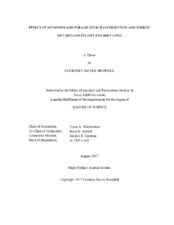| dc.description.abstract | As beef demand increases and available land resources are diminished, innovative approaches to livestock production are required to meet global demand for food. One such strategy is the intensification of cow-calf systems, which allow for greater dietary control during times of limited forage availability. Monensin, an ionophore feed additive, may have value in intensified cow-calf operations by increasing feed utilization and energy efficiency. Furthermore, forage source may affect digestion and ruminal fermentation of limit-fed diets. Three experiments were designed to determine the effect of monensin on energy and nitrogen balance in nutrient-restricted bred heifers and to evaluate the effect of differing forage sources in a limit-fed total mixed ration (TMR) as well as consequences of limit feeding on voluntary intake and ruminal fill. Monensin had no effect on intake (P > 0.94) or digestion (P > 0.52) in limit-fed bred heifers. There were also no differences (P > 0.16) observed in fecal, urinary, methane, or heat energy losses due to monensin inclusion, and thus, monensin also had no effect (P = 0.36) on RE. Nitrogen balance did not differ (P > 0.13) between control and monensin heifers. In assessing the inclusion of varying forage sources in a limit-fed TMR, DE intake was greater (P < 0.03) for bermudagrass than alfalfa with milo stalks being intermediate. Dry matter digestion (DMD) was greater (P < 0.02) for wheat straw and bermudagrass than milo stalks, and there was a tendency (P = 0.06) for alfalfa DMD to be lower than wheat straw DMD. Organic matter, NDF, and ADF digestion were greater (P < 0.02) for wheat straw than alfalfa or milo stalks. Ruminal DM fill was not different (P = 0.18) between treatments and averaged 4.90 kg; however, liquid fill was greater (P < 0.02) for alfalfa and milo stalk treatments than bermudagrass with a tendency (P = 0.06) for wheat straw to also be greater than bermudagrass. Ruminal solid passage rate was greatest (P < 0.01) for steers consuming wheat straw diets and not different between bermudagrass, alfalfa, and milo stalk diets. Dry matter intake and ruminal DM fill following feed restriction remained lower (P < 0.04) than pre-trial levels, while ruminal liquid fill returned to pre-trial levels by d 10 of refeeding. Results of these experiments suggest that adding monensin to limit-fed, corn stalk-based diets has little effect on the energy and nitrogen balance of confined heifers. Additionally, there does not seem to be a clear advantage of feeding one forage over another when considering limit-fed TMR, and voluntary intake and ruminal fill are not restricted following a prolonged period of limit feeding. | en |


